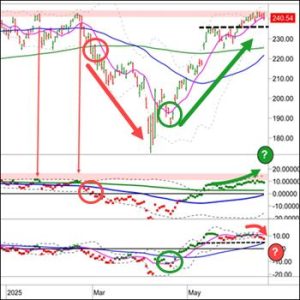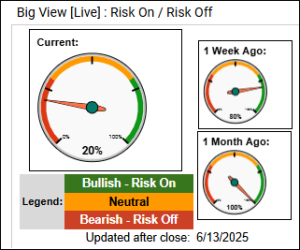Last week, the news flow around tariffs rocked the markets like small craft in stormy seas, and the end result has become an uncomfortable trend.
The SPY closed with the worst 3-week slide since Dec 2022. This makes it the worst 3-week slide of the current bull market. At the low for the week and Friday, the pullback from the all-time highs measured over 7%.
Nasdaq’s performance based on the QQQ was similar but more volatile. It had its second worst 3-week slide of the bull market behind last August’s tech rout, and at its low on Friday, the drawdown exceeded 11%. Wall Street labels a move of down 10% or more as an official “correction.”
The $64,000 question is, “Will the administration’s policies relating to tariffs create a bear market?”
Considering the amount of tariffs proposed as shown in the chart below, it’s understandable that investors, the Fed, and even the administration would be considering this question seriously.
Last week, each of these three parties independently demonstrated there is some common ground in their belief on how markets will respond to the current execution of tariffs.
In his address to the nation, President Trump described them as potentially creating a “little disturbance”.
On Friday, in a speech that seemed to instigate a market reversal at the low of the day, Chairman Powell described the path forward for markets and data as “bumpy.”
Wall Street strategist has a long-standing definition for describing markets that decline 10% from their highs, “Corrections,” and the QQQ earned that designation last week.
Such agreement is welcome, but that doesn’t answer the questions you most likely care about most.
When markets get volatile and there’s more pressure on the question of should you ‘hold on’ or exit positions, the value of trading with automated systems becomes clear.
This is because automated trading strategies address two big reasons discretionary traders struggle over the long term. First, investors tend to get out of the market at the wrong time. Second, investors who exit positions without having a clear plan to reenter often don’t re-enter at a good time and compound problem of taking losses by not enjoying the potential gains.
Without even getting into the details of market timing rules, automated trading strategies can ensure that you don’t make these two and several more common mistakes that can kill your long-term performance.
Summary: Markets are at critical turning points with very mixed reads, as the bullets highlight below. A case could be made for strong mean reversion or a continued move lower.
Risk On
- The weekly trends in the NASDAQ, S&P, and Dow remain in bull phases, while IWM is in a warning phase. Friday’s reversal in the S&P could be bullish if confirmed. (+)
- European equities rallied strong this week. (+)
- Both emerging markets and more established foreign equities exploded to the upside, attacking the all-time highs set back in 2008. (+)
Neutral
- On the daily charts, the indexes appear to be breaking down, though all four indexes are oversold on Real Motion and could be poised for a bounce. The S&P tested it’s 200-Day Moving Average and closed slightly above it. IWM is in a distribution phase. (=)
- The number of stocks above key moving averages may have reversed course in the S&P and its also looking like potential bottoming action in IWM. If S&P we can clear the 50 percent level on both the 10-Day and 50-Day, that could be a positive sign. (=)
- In the modern family, Semi-conductors entered into a bear phase, though it is oversold on both real motion and price. Biotech held up in a recovery phase and outperformed the S&P over the last couple weeks. (=)
- The moving average of the number of stocks above key moving averages, on both the 50 and 200 are neutral, which considering the market action, is neutral for the markets. This is for the S&P, NASDAQ, and Dow. (=)
- Volatility remains elevated with the broader market sell-off. We are still under the peaks from last fall so this could indicate we are set up for mean reversion (=)
Risk Off
- Across the four indexes, we have only three accumulation days and 15 distribution days over the last two weeks. (-)
- The sector performance this week showed clear signs of risk-off with money flowing to risk-off sectors like gold miners and healthcare.
- The McClellan Oscillator is clearly negative and respecting an important trendline in this negative move, which could reverse, but for now, remains negative. (-)
- The new high new low ratio is still trending down, though its starting to get into oversold territory. (-)
- Risk gauges improved from a 0% to 20% with an improvement in the wood vs gold ratio, possibly related to tariffs. (-)
- Value continues to lead growth, although it closed in a warning phase, and as long Value remains under its 50-Day Moving Average and growth remains under its 200-Day Moving Average, this reading remains risk-off. (-)
- Gold was up 2% on the week, closing just under all-time highs, exhibiting a traditional risk-off relationship to the S&P. (-)
- On the longer-end of the yield curve, rates rejected their 200-Day Moving Averages and retraced to important support, with no clear direction based on price action. (=)
- The dollar got crunched across the board against other currencies this week and is at its lowest levels since last November. Bitcoin, generally a good risk-on indicator, is under $90k. (-)
- Based on seasonality trends, we expect the markets to remain under pressure for the next week or two with an improving trend towards the end of the month. (-)













